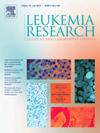在新疗法时代,单点与多点tp53突变的慢性淋巴细胞白血病的临床病理学、遗传学和预后特征
IF 2.2
4区 医学
Q3 HEMATOLOGY
引用次数: 0
摘要
背景tp53改变是慢性淋巴细胞白血病(CLL)最重要的不良预后遗传指标;然而,TP53等位基因状态的重要性,即单命中(SH)与多命中(MH)状态,并没有很好地表征,特别是在生物靶向治疗的背景下。方法回顾性研究2019年1月至2024年5月在我院诊断为tp53突变的CLL并接受靶向治疗的患者。比较SH和MH tp53突变CLL组的临床、遗传和生存数据。结果共检出58例TP53突变,其中SH 13例(22.5 %),MH 45例(77.5 %)。MH tp53突变的cll表现出明显更高的贫血、中性粒细胞减少症和血小板减少症,更频繁的复杂核型(82.3 %对25 %;P = 0.0001),共突变基因数量较高(中位数:1.68 vs. 1.23个突变/例;p = 0.03)。然而,临床症状的严重程度、脾肿大的频率、血清LDH、Rai分期、需要治疗干预、第一次治疗时间、需要>; 1线治疗时间、第二次治疗时间、Richter转化的发生率和总生存率(MH与SH的2年和5年生存率分别为69 %对75 %和52 %对75 %;p = 0.48)在SH和MH tp53突变的cll之间无显著差异。结论:我们的研究表明,SH tp53突变的cll具有其MH对应细胞的一些不良临床病理特征。认识到SH tp53突变的CLL是一个高风险遗传亚群,对于确保这些患者的精确预后和最佳治疗至关重要。本文章由计算机程序翻译,如有差异,请以英文原文为准。
Clinicopathologic, genetic, and prognostic characteristics of single-hit versus multi-hit TP53-mutated chronic lymphocytic leukemia in the era of novel therapies
Background
TP53 alteration is the most important adverse prognostic genetic indicator in chronic lymphocytic leukemia (CLL); however, the significance of the allele status of TP53, i.e., single hit (SH) vs. multi hit (MH) state, is not well characterized, particularly in the context of biological targeted therapies.
Methods
We retrospectively studied patients diagnosed with TP53-mutated CLL and treated with targeted therapies at our institution between 01/2019 and 05/2024. Clinical, genetic, and survival data were compared between SH and MH TP53-mutated CLL groups.
Results
A total of 58 cases were identified, including 13 (22.5 %) with SH and 45 (77.5 %) with MH TP53 mutations. MH TP53-mutated CLLs showed significantly greater anemia, neutropenia, and thrombocytopenia, more frequent complex karyotypes (82.3 % vs. 25 %; p = 0.0001), and a higher number of co-mutated genes (median: 1.68 vs. 1.23 mutations/case; p = 0.03) compared to SH cases. However, the severity of clinical symptoms, frequency of splenomegaly, serum LDH, Rai staging, need for therapeutic intervention, time to first treatment, need for > 1 line of therapy, time to second treatment, incidence of Richter transformation, and overall survival (2 and 5-year survival rates for MH vs. SH: 69 % vs.75 % and 52 % vs.75 %, respectively; p = 0.48) did not differ significantly between SH and MH TP53-mutated CLLs.
Conclusion
Our study demonstrates that SH TP53-mutated CLLs share several of the adverse clinicopathologic attributes of their MH counterparts. Recognizing SH TP53-mutated CLL as a high-risk genetic subgroup is essential to ensure precise prognostication and optimal therapy for these patients.
求助全文
通过发布文献求助,成功后即可免费获取论文全文。
去求助
来源期刊

Leukemia research
医学-血液学
CiteScore
4.00
自引率
3.70%
发文量
259
审稿时长
1 months
期刊介绍:
Leukemia Research an international journal which brings comprehensive and current information to all health care professionals involved in basic and applied clinical research in hematological malignancies. The editors encourage the submission of articles relevant to hematological malignancies. The Journal scope includes reporting studies of cellular and molecular biology, genetics, immunology, epidemiology, clinical evaluation, and therapy of these diseases.
 求助内容:
求助内容: 应助结果提醒方式:
应助结果提醒方式:


